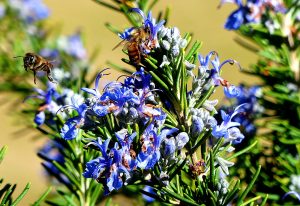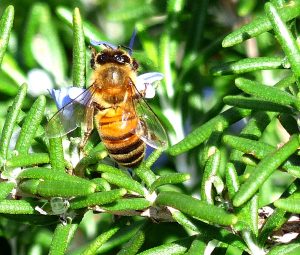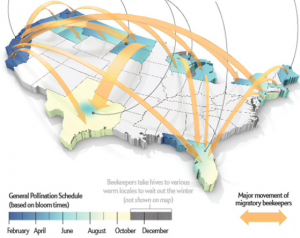I had planned to use bees as a springboard to talk about human excess and then I had to laugh at myself when I read the final sentence of last week’s post expressing my desire for more, more, more honey.

We have much in common with bees; they, too, indulge in excess. They will overcrowd a hive until it is intolerable, at which point many of the bees leave looking for a new place to live. They apparently do not consider living within the means of the hive or ceasing to make new babies. Like humans. Many scientists and other imaginative people now puzzle how to leave Earth to populate Mars or other planets. Books, movies and TV routinely tell stories about humans escaping an overcrowded, ravaged Earth. At the same time, we stand by while 40% or more of our bee population dies annually to produce our food.
Bees have been around much longer than humans, 150 million years more or less, but they share with humans and with cockroaches and sharks, the ability to survive disaster and to adapt. When all the flowers and trees died during desertification in an area, they moved, when glaciers moved into tropical Europe, bees moved. Some bees adapted to cold weather, others to hot weather. They traveled the globe as opportunists, changing as necessary to fit the climate, the water supply and the food sources Like humans.

Historically, we love bees. Napoleon made the bee a national symbol, the bee as a metaphor for human society crops up in Aristotle, Plato, Virgil, Shakespeare; ancient Greek and Hindu writings imagined honey on human lips as a conduit to eloquence; the Quran includes a chapter entitled, “The Bee”; bees signified immortality and were used by royalty of ancient Italian houses and the Franks.
Now we are working honey bees to death and poisoning them.
The annual honey bee loss is called Colony Collapse Disorder is reputed to have unknown causes. These losses are considered business as usual; just another part of American agriculture on a grand scale. Commercial honey bees lead grinding miserable lives; they are raised in factory farms to make up for the losses, then loaded onto trucks and used for pollination again and again. In conjunction with wild bees, these traveling honey bees pollinate about 80% of U.S. crops—value: $40 billion annually.
For almonds alone, more than a million bee boxes ship into California from all over the country on thousands of trucks. Other bees travel by truck to pollinate cherry, plum, avocado and apple trees; alfalfa, sunflowers, squashes, citrus, cranberries and blueberries– countless vegetables. https://www.scientificamerican.com/article/migratory-beekeeping-mind-boggling-math/
 The migratory practice shown in the picture guarantees the spread of viruses, mites and fungi between the hives; using the bees on a single crop limits their nutrition needs and exposes the bees to a wide variety of pesticides. The traveling bees have abnormal gland sizes, lowered protein in their heads, low lipid content in their abdomens and a high mortality of older bees. https://www.hindawi.com/journals/psyche/2012/193029/
The migratory practice shown in the picture guarantees the spread of viruses, mites and fungi between the hives; using the bees on a single crop limits their nutrition needs and exposes the bees to a wide variety of pesticides. The traveling bees have abnormal gland sizes, lowered protein in their heads, low lipid content in their abdomens and a high mortality of older bees. https://www.hindawi.com/journals/psyche/2012/193029/
A study has found 35 pesticides and fungicides, some at lethal doses, in the pollen collected from bees that were used to pollinate food crops in five U.S. states. http://www.newsweek.com/bee-populations-vanish-usda-tries-keep-them-fed-230271 The British have linked neonicotinoid pesticide use and honeybee colony collapse. Neonicotinoid pesticides are banned in Europe but used widely here although these chemicals are highly toxic and will kill bees even in tiny amounts.http://www.rollingstone.com/politics/news/pesticides-killing-bees-study-shows-what-everybodys-suspected-20150826 Many of the plants at my Home Depot are marked as treated with neonicotinoids, which would, if I bought them, be a danger to my bees.
So a mortality rate of 40% or more of honey bees each year is not really very mysterious. This death and misery is to produce our fruits, vegetables, nuts and grains; 30% to 40% of this food harvest is not consumed, but becomes food waste and ends up in the garbage dump. http://www.usda.gov/oce/foodwaste/faqs.htm
Human excess. You can’t make this stuff up.